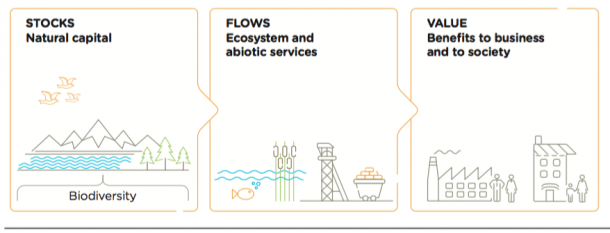Natural capital from an LCA perspective
August 2, 2016 by Bo Weidema
Last month, on July 13th, the Natural Capital Coalition published their Natural Capital Protocol, which is a framework for performing Natural Capital Assessments “designed to help generate trusted, credible, and actionable information that business managers need to inform decisions”.
Natural Capital is defined as “The stock of renewable and non- renewable natural resources (e.g., plants, animals, air, water, soils, minerals) that combine to yield a flow of benefits to people”. These flows can be ecosystem services or abiotic services, which provide value to business and to society, and thus includes the impacts on human capital that go via impacts on natural capital (e.g. clean air). The Natural Capital Protocol thus covers the same issues as traditional biophysical Life Cycle Assessment (see also my March 2015 blog on the terminology of Natural Capital Accounting).
Figure 1.1 from Natural Capital Protocol (2016). Licensed under a Creative Commons Attribution-NonCommercial-NoDerivatives 4.0 International License.
The framework largely follows that of Life Cycle Assessment (LCA), starting with the goal definition in Chapter 2: “Define the objective” including target audience and stakeholder engagement. The scope definition in Chapter 3 covers the determination of the focus (organizational, project or product), the extent of the life cycle perspective (here called “boundary”: cradle-to-gate, gate-to-gate, downstream), the stakeholder perspective (here called the “value perspective”: own business only, society, and/or specific stakeholder groups), type of valuation (qualitative, quantitative, monetary), and “other technical issues”: baselines, scenario alternatives, spatial and temporal boundaries.
The Natural Capital Protocol continues by describing screening (Chapter 4: Which impacts and/or dependencies are material?), inventory (Chapter 5: Measure impact drivers), impact assessment (Chapter 6 on the measurement of state changes, i.e. impacts), valuation (Chapter 7), interpretation (Chapter 8) and taking action (Chapter 9).
The largest difference to LCA seems to be the particular focus on what the Protocol calls Natural Capital dependencies, which is an optional risk assessment of the supply security and liabilities related to use of Natural Capital and the precautionary measures that the business takes to reduce these security and liability issues. Such a risk assessment should be part of normal business practice, but is not part of LCA, while the practical measures taken will be part of a life cycle inventory and the impacts of these measures are thus included in the LCA results.
For people familiar with LCA, the Natural Capital Protocol may not contain much new, but the Protocol is a good, simple introduction to environmental assessment from a business perspective and an important call for business to take action.
Reference:
Natural Capital Protocol (2016). Available: www.naturalcapitalcoalition.org/protocol